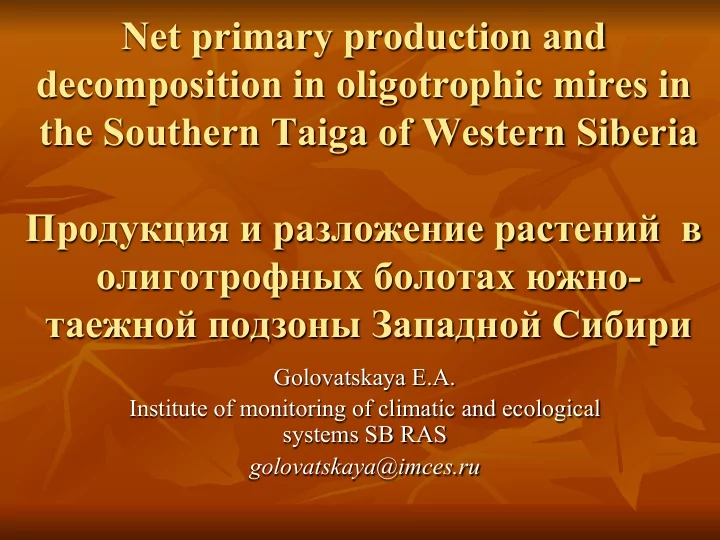

Net primary production and decomposition in oligotrophic mires in the Southern Taiga of Western Siberia Продукция и разложение растений в олиготрофных болотах южно - таежной подзоны Западной Сибири Golovatskaya E.A. Institute of monitoring of climatic and ecological systems SB RAS golovatskaya@imces.ru
Peatlands covering only 3% of Earth ’ s land area, they hold the equivalent n of half of the carbon that is in the atmosphere ac CO 2 . Most peatlands are located in the boreal and subarctic Northern n Hemisphere, where the climate is warming faster than anywhere else on the Earth. The carbon accumulation rate of peatlands is determined by the balance n between the amount of carbon sequestered in the net primary production (NPP) and the amount of carbon lost to the atmosphere by decomposition of dead organic matter. Rates of net primary production in peatlands are generally small, as are n rates of net ecosystem exchange of CO 2 and soil respiration. Thus, the accumulation of organic matter in peatlands is generally ascribed n to slow rates of decomposition associated with cool temperatures, anoxic conditions, and functionally limited decomposer communities .
Peatland of West Siberia Total area - 592 440 km 2 , Total weight of peat - 148 Gt Peat carbon pool - 70 Gt C Sheng, Y., L. C. Smith, G. M. MacDonald, K. V. Kremenetski, K. E. Frey, A.A. Velichko, M. Lee, D. W. Beilman, and P. Dubinin (2004), A high-resolution GIS-based inventory of the west Siberian peat carbon pool // Global Biogeochem. Cycles, 18, GB3004, doi:10.1029/2003GB002190.
Site description The study area is located between the Iksa and Bakchar rivers (56 o 58`N 82 o 36`E) at the territory of the Bakcharskoe bog (bog area 1400 km 2 ) and is characterized by regular changes of oligotrophic bog ecosystems: pine– shrub–sphagnum community, a similar community with oppressed (low) tree stand, ridge-hollow complex and sedge– sphagnum open bog. Field station “ Field station “Vasuganie Vasuganie” ” 160 km 160 km
The observation has been conducted on the oligotrophic and eutrophic mires at the field station “Vasuganje” (IMCES SB RAS, Tomsk region, Western Siberia). Vegetation at the observation points are: Ryam – pine-shrub-sphagnum ecosystem Fen sedge-sphagnum ecosystem
Methods Biological productivity: Net primary productivity and vegetation storages was measured by clipping method. The aboveground biomass was measured by clipping 50x50 cm quadrates. The belowground biomass was determined by the excavation of 10 x 10 cm pits at each quadrate. Decomposition of plants was studied using the litterbag technique. Decomposition rates were calculated from mass looses for different vegetation species.
Net Primary Production Net primary production (NPP) is an indicator of carbon accumulation in the form of vegetation n matter. NPP for low ryam and sedge-sphagnum fen are equal to 587, and 571 g m − 2 yr − 1 . The main part of n production at studied ecosystems is consist of by roots of herbs and shrubs (47–51%) and sphagnum mosses (30– 31%). Shrubs give 17 % to NPP at low ryam. The contribution of herbs is more significant at sedge-sphagnum fen (16 %) but the proportion of shrubs is about 7%. 700 grasses shrubs moss roots 600 500 NPP, g/m2year 400 300 200 100 0 Pine-shrub-sphagnum ryam Sedge-sphagnum fen
Initial Carbon (C), Nitrogen(N) and Ash (A) concentrations in plant matter C,% N,% C/N A,% Mosses 39,7 0,5 77,7 2,0 Grasses 43,2 1,4 33,4 4,2 Shrubs 49,4 1,2 41,2 2,6 (leaves)
Mass loss of plant matter in pine- shrub-sphagnum community 45 40 35 30 Mass loss, % 25 20 15 10 5 0 Rubus Andromeda Ledum palustre Chamaedaphne Sph. fuscum chamaemorus polifolia calyculata
Mass loss of plant matter in sedge-sphagnum fen 80 70 60 Mass loss, % 50 40 30 20 10 0 Menyanthes Carex rostrata Eriophorum Scheuchzeria Oxicoccus Sph. trifoliate vaginatum palustris palustris Magellanicum
Pine-shrub-sphagnum ryam 45 Changes in 40 concentration of Carbon loss (% of initial C) 35 carbon in plant 30 matter 25 20 15 10 5 0 Rubus Andromeda Ledum palustre Chamaedaphne Sph. fuscum Sedge-sphagnum fen chamaemorus polifolia calyculata Sedge-sphagnum fen Pine-shrub-sphagnum ryam 70 60 Carbon loss (% of initial C) 50 40 30 20 10 0 Menyanthes Carex rostrata Eriophorum Scheuchzeria Oxicoccus Sph. trifoliate vaginatum palustris palustris Magellanicum
180 NPP Mass remaining 150 NPP, g/m2 year; Mass remaining, g Carbon balance of peatland ecosystems can be estimated using 120 data on vegetation NPP and 90 decomposition rates. Studied 60 ecosystems have positive carbon balance. 30 0 Grasses Shrubs Moss Pine-shrub-sphagnum ryam Sedge-sphagnum fen During the first year decomposes only 180 NPP 13% from the annual productivity at low Mass remaining, g NPP, g/m2 year; 150 Mass remaining ryam, and 25% at sedge-sphagnum fen. 120 Carbon accumulation in a form of peat is higher than carbon removing with 90 carbon dioxide emission at plant 60 remains decomposition. 30 0 Grasses Shrubs Moss
Conclusion Despite the differences in composition of the vegetation the average values n of NPP are similar at all oligotrophic ecosystems. The rates of decomposition of the plant matter depends on species of n plants. The main peat-forming species are sphagnum moss. n Carbon accumulation in a form of peat is higher than carbon removing with n carbon dioxide emission at plant remains decomposition.
Thank you for the attention! Western Siberia Bakchar key area Bakcharskoe bog
Recommend
More recommend